New CalFresh ‘super clinics’ to help hungry students
Campus and county are partnering to enroll students in federal food assistance program; some 10,000 students likely eligible
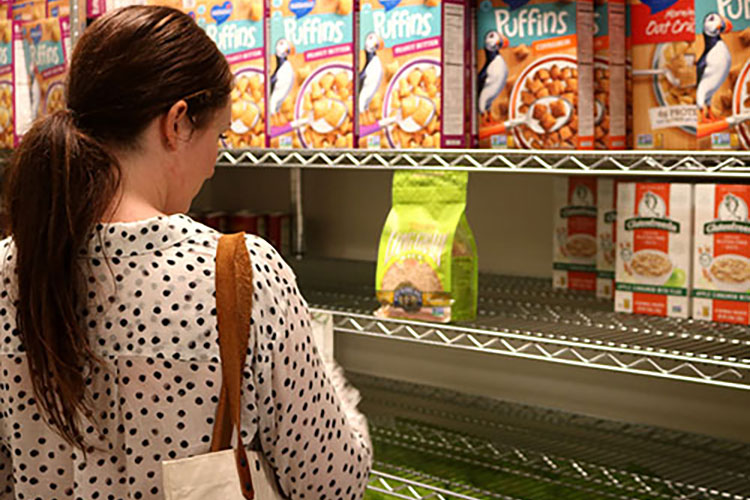
September 22, 2017
A major push will start in October at UC Berkeley to begin helping an estimated 10,000 students apply to CalFresh, a federally funded nutrition program that issues a free debit card for groceries to those who qualify. According to the Alameda County Community Food Bank, which runs the program on campus, most individual college students who are eligible can receive up to $193 in benefits a month.
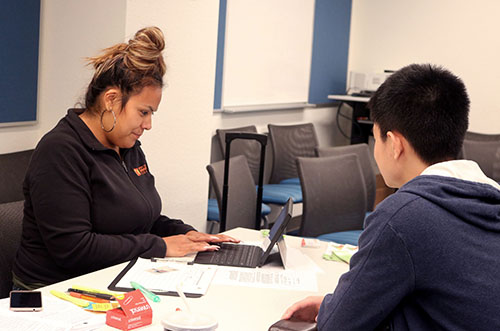
CalFresh clinics that Patricia Figueroa, from the Alameda County Community Food Bank, runs at Berkeley have grown from one a month to every Friday. (UC Berkeley photo by Kirpa SIngh)
A CalFresh “super clinic” will be held one Friday a month to introduce approximately 50 students at a time to the program. Currently, about 25 students attend CalFresh clinics on Fridays in Stiles Hall, on the lower level of the ASUC Student Union’s Martin Luther King Jr. Building, for one-on-one help with their applications. Pre-registration is required for all clinics. Logistics for the super clinics will be available online soon.
“We’re projecting to drastically increase the amount of our students on CalFresh, with the goal this school year of enrolling 200 a month – that’s compared to 200 students, total, last year,” says Ruben Canedo, chair of the UC Berkeley Basic Needs Committee.

Stiles Hall, on the lower level of the MLK Jr. Building, is CalFresh headquarters. The UC Berkeley Student Food Pantry is next door. (UC Berkeley photo by Kirpa SIngh)
“We started with one clinic a month at UC Berkeley in May 2015 and would see four to five students, but now we’re here every Friday,” says Patricia Figueroa, outreach coordinator for the Alameda County Community Food Bank. She and a colleague from the organization’s 13-member, multilingual CalFresh Outreach Program facilitate the Berkeley clinics. “I’m super excited,” she adds. “This effort’s come a long way.”
Across the UC system, 48 percent of undergraduates and 25 percent of graduate students reported in a 2015 Nutrition Policy Institute survey that they are food insecure, meaning they can’t access adequate food due to a lack of money and other resources. Canedo says the study remains the largest one by sample size — 8,900 students — among the nation’s four-year and graduate schools.
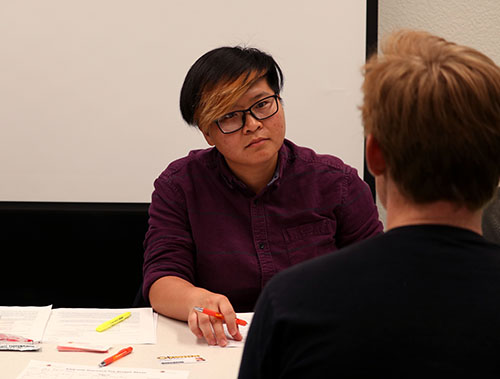
One-on-one CalFresh clinics are held on Fridays in Stiles Hall; super clinics will start in October. (UC Berkeley photo by Kirpa Singh)
College students’ eligibility for CalFresh is based upon factors including whether they are Cal Grant A or B recipients, Pell Grant recipients, eligible for federal work-study jobs or are in campus programs that support students from populations that historically experience basic needs insecurity, including former foster youth, student-veterans and first-generation college-goers.
Canedo says that at Berkeley, at least 9,000 undergraduates and 1,000 graduate students meet the criteria for CalFresh, and that “10,000 is a conservative figure.”
“There is a student need,” adds undergraduate Hong Heng, the campus coordinator for CalFresh, a program she also uses, “and one of the reasons I got involved is because students who are starving can’t succeed academically. With CalFresh, hopefully ‘When’s my next meal?’ won’t be a question.”
Contrary to what many college CalFresh applicants believe, “it’s absolutely true that being awarded CalFresh benefits has no impact on their financial aid,” says Cruz Grimaldo, director of the Financial Aid and Scholarships Office. “Those kinds of benefits are excluded in the calculation of a students’ financial capacity and are not considered a resource.”
Next month, says Canedo, a message targeting Cal Grant recipients will be issued by the financial aid office through CalCentral, inviting those students to sign up for a CalFresh super clinic.
Pantry experiencing ‘highest usage’ yet
On a recent Friday, volunteers at the popular UC Berkeley Food Pantry were restocking shelves for the second time that week. The pantry is a source of healthy food for more than 2,500 Berkeley students, but “it really should be called an emergency food pantry, since it’s just that – an emergency relief food supply for supplemental nutrition,” says Canedo.
In the first week of school alone, the pantry – next door to Stiles Hall in the MLK Jr. Building and part of a toolkit of campus food security resources – ran out of food twice. The pantry has been visited about 1,820 times since school started; during each of those four weeks, 455 students dropped by to pick up the five non-perishable items they’re allowed twice a month.

Ruben Canedo, chair of the UC Berkeley Basic Needs Committee, says the campus food pantry is busier than ever. (UC Berkeley photo by Hulda Nelson)
“At this moment, we have the highest usage of the pantry since it opened in spring 2014,” adds Canedo. “We’ve had to double-stock the pantry back-to-back for weeks.” The food items – some donated, others purchased at low cost – come from multiple sources, including United Natural Foods Inc., the Alameda County Community Food Bank, the Berkeley Student Food Collective, Clif Bar, Acme Bread Company and student gardens.
But the pantry, with its very limited square footage, isn’t set up for the foot traffic it’s experiencing. “We’ve outgrown this space, and space is very limited on campus, so we have to make the most of what we have,” explains Canedo. “We also can’t order too much food because it doesn’t all fit, and we also lack funds for a few more freezer display cases, to store frozen foods.”

About 400 students came to the food pantry during the first week of classes this fall. (UC Berkeley photo by Kirpa Singh)
“Our ultimate goal,” he adds, “is to establish a center where all our basic needs programs can take place. UC Irvine is opening one in October that will be a fully integrated facility with a food pantry, a cooking space, a teaching space, offices and a multipurpose space. This should be a vision and a goal for every campus.”
Canedo recently launched the campus’s new comprehensive Basic Needs Security website, a model repository of resources for students in need. He also is food/basic needs co-chair of UC President Janet Napolitano’s Global Food Initiative and is co-producing a report on the basic needs of UC students system-wide.
The uptick in students visiting the campus food pantry and enrolling in CalFresh can, in large part, be explained by the high cost of housing in the Bay Area, says graduate student Allen Ratliff, a Graduate Assembly delegate and chair of the Graduate Assembly’s Basic Needs Security Workgroup.
“Graduate students are spending substantial percentages of their income on rent, which means they have less to spend on food,” explains Ratliff. “The critical housing shortage and cost of housing affects the ability of graduate and undergraduate students to pay for healthy food. No student should need to receive CalFresh in order to have enough to eat; they should be funded well enough to eat. That said, many students need the support of CalFresh, and it is vital to expand access to CalFresh and the food pantry.”
No more food stamps
CalFresh is a federally mandated, state-supervised and county-operated assistance program known outside of California as the Supplemental Nutrition Assistance Program (SNAP). SNAP provides federally funded food benefits to low-income Californians, and in 2014, it began reducing barriers for college students to apply.
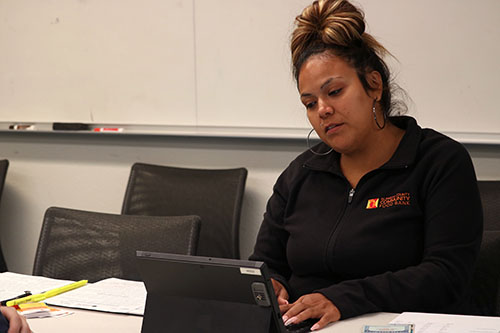
Figueroa visits Berkeley each week to help students sign up for CalFresh. (UC Berkeley photo by Kirpa Singh)
But many students are unaware of the CalFresh program, feel they may not qualify or don’t know how to apply. “There’s a lot of misinformation about it,” says Figueroa. “Many people think, ‘Food stamps? I don’t want anything to do with that.’ But all you have to do is carry what looks like a debit card, a card anyone would carry, and it gets replenished on a monthly basis.”
“This generation will have no knowledge of food stamps – we don’t use that language,” she adds, “and food stamps don’t exist.”
What began as a grocery program now allows CalFresh enrollees to purchase food not only at supermarkets, but also at select farmer’s markets and a few restaurants, says Heng, adding that “many of these options are within walking distance of campus.” On Dec. 1, the campus’s Bear Market at 2400 Durant Avenue also will accept the CalFresh card.
After applying, students wait about a month to hear if their applications have been accepted. The current approval rate for Berkeley students’ CalFresh applications is 80 percent, says Canedo, adding that having county food bank employees help students apply is key. “That’s why we bring them onto campus,” he adds.
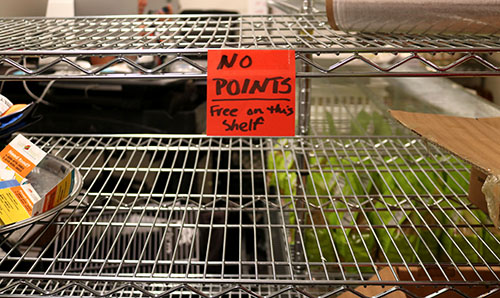
The campus pantry allows students to choose five items per visit, but it also offers extras, like bread and fresh produce, that don’t count toward the limit. Those items can disappear quickly. (UC Berkeley photo by Kirpa Singh)
“We’re hoping to have upward of a 90 percent acceptance rate,” says Canedo. “We’ll be able to learn who was denied and why at mid-semester and then can appeal, since all students have been pre-screened in our CalFresh clinics.”
Berkeley also has partnered with the nonprofit Code for America, which has created GetCalFresh, a mobile-friendly site to help students find out if they’re eligible for CalFresh in about 10 minutes. Figueroa and her staffers use GetCalFresh to submit students’ applications, and to track and connect more easily with applicants. If students can’t attend a clinic, says Canedo, they’re welcome to apply on their own.
The CalFresh Outreach Program also will be available to conduct special CalFresh super clinics on campus Monday through Thursday for up to 80 students at a time who might be more comfortable attending with peers they relate to best.
For example, says Ratliff, graduate students “have described fears of encountering the undergraduate students they teach in the food pantry and at CalFresh clinics, and that’s a barrier to accessing those resources. The food pantry has hours specifically for graduate students, to alleviate this concern, and there need to be CalFresh clinics provided exclusively for graduate students, too.”
Figueroa says she isn’t worried about a steep rise in the number of students that will likely apply for CalFresh in the coming months, as she has more team members to deploy – all of them dedicated to helping hungry students enroll in the program.
Canedo agrees, adding, “That’s a good problem to have.”